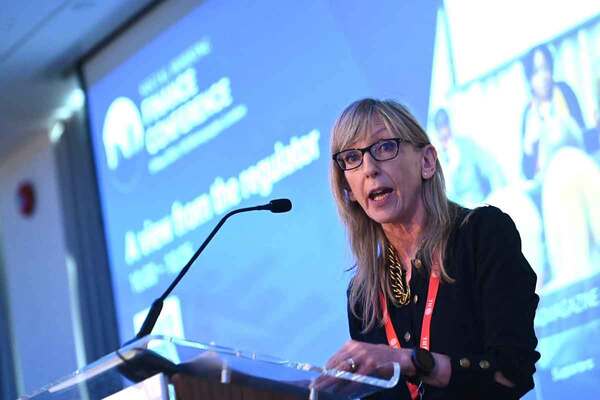You are viewing 1 of your 1 free articles
Talking to dragons
Ideas were a key theme at this year’s Chartered Institute of Housing (CIH) event – nowhere more so than at the Dragons’ Den-style event at The Treehouse Fringe.
The prize at the ‘Game-Changer for Communication in Housing’ session was a free delegate pass to next year’s CIH Housing event.
In the end, the Dragons were impressed by all three pitches and so each of the three received a free pass to next year.
Here are the ideas from those who dared to enter the Dragons’ lair.
Khannie Saccoh, customer engagement officer, Orbit Group

The way we think about communication is changing. Customers are now getting in touch on the go using their mobile phones and tablets, by accessing social medial channels like Facebook and Twitter, while they continue with their day.
Digital is becoming an essential part of the customer journey and Omnichannel is a new tool, available to help ensure our customers experience a consistent service and familiarity across multiple communication channels.
This is why my pitch to the Dragons’ Den in The Treehouse Fringe at the Chartered Institute of Housing’s annual event in Manchester was all about why social landlords must consider moving beyond just the telephone and Facebook in communicating with their customers. If they don’t, they are missing a big trick.
Omnichannel is used to capture customer data and convert it from one channel to another, giving the customer a continuous and consistent approach across all channels as a result. This means that a conversation that begins on Twitter can be continued via text message or phone call with the entire conversation conserved across all channels.
Now, more than ever before, the ease of starting a conversation in one channel, then continuing in another, is extremely important and allows us to provide a much better quality of customer service.
Our customers don’t necessarily think about what channel they are using to contact us. The most important thing to them is that they get the answer to their question or a solution to their problem as quickly and conveniently as possible. This could be anything from reporting a repair, to checking their rent statement, or asking about the large variety of community investment programmes Orbit offers.
Around 67% of our tenants and 88% of leaseholders have access to the internet. Therefore, the ability to access services online is an increasing requirement moving forward. Our residents can get in touch with the contact centre using the telephone, web chat, Facebook, Twitter, email or ‘Rant & Rave’ – our innovative, sector-leading, real-time feedback platform.
Orbit’s goal is to have 75% of customer transactions completed online by 2020, and to maintain the digital culture. Omnichannel is one of the tools that will help us to achieve this goal with a successful cross-channel communication strategy. This will allow our different customer segments to contact us using the most convenient method for them and their lifestyle.
Having worked at Starbucks myself, I have seen how Omnichannel works in improving customer experience and making staff jobs easier. Customers have a reward app, but unlike traditional customer loyalty schemes, Starbucks has made it possible to check and reload customer rewards cards via phone, website, in-store, or on the app.
To me, Omnichannel is an innovative evolution in engaging with customers in the future as it allows customers to interact with us whenever, wherever and however they want to.
Nina Erskine, deputy service manager, Loretto Care Tenancy Support Service

My pitch at the ‘Game-Changer for Communication in Housing’ at the CIH conference came from a slightly different slant to that of the other pitchers. This was due to the fact that we at the Tenancy Support Service provide housing support as a wrap-around service, to complement the work of housing officers and the other wrap-around services within our wider organisation – Wheatley Group.
The main aim is preventing tenancy failure. We provide housing support to people referred to us by housing officers from across the social landlords in Wheatley. People referred to us have varying needs: addiction, mental health issues, learning difficulties, physical difficulties, young people, older people and those from migrant communities. Many of them are from the harder-to-reach sections of the community.
My pitch was centred around taking our services to the people. This includes the use of tablets for our assessments. This would introduce technology to customers, which could then lead on to us supporting someone with the 27 ‘Click and Connect’ centres in Glasgow which we have set up in partnership to provide free access to computers and training. Many of the people we work for are just not online at the moment and therefore are excluded from so much we all take for granted.
Another idea was introducing the use of animation videos on tablets – to explain different issues to people; for example, housing benefit, universal credit, repairs, wrap-around services, including an overview of our own service. This would break down barriers for those with literacy issues, and we could also introduce these videos in other languages so that those whose first language is not English were also included.
My final idea was to encourage people we work for to become involved in housing issues, like leading a campaign or setting up a group, as members of the local community are more likely to relate to someone from their own community, particularly migrant communities or young people.
In true Dragons’ style, I asked for funding. However, my bid was unsuccessful!
Alex Lamb, housing officers, West Lothian Housing Partnership (WLHP), part of Wheatley Group

Our team has been looking at ways in which we could most effectively communicate with all of our customers.
We started by looking at our customer satisfaction results and really wanted to understand, in depth, what our customers thought of the services we provide, what our customers expected of us as a landlord and what we could do better.
It was evident that what we assume the best way to contact us is – during business hours, visiting a central office or even using social media and emails – wasn’t entirely capturing our complete customer base. As a team, we agreed that we could excel in the way we communicate with our customers by breaking away from the customary approach.
Over the summer months, the team are going out on Saturday mornings directly to the customers’ doorsteps. We like to call it ‘meet and greet, right in your street’. We pitch up a gazebo directly in the streets of the communities we serve, inviting the residents to come and have a chat with us over a cuppa and cake.
We ask them to tell us what they would like to see happening in the communities in which they live, encouraging them to tell us what they think of the environment and our repairs service. We take note of their ideas on how we could best invest their rent money in terms of capital programmes, cyclical maintenance etc.
And we’re not just asking them all the questions. We arrive with information before they even ask for it. Using our current reporting systems, we’re able to take with us detailed information like year-to-date repairs spend in that particular street, right down to the individual property.
Other information we have to hand is pre-identifying if a customer has had cause to complain. We ask how they think the complaint was handled and what we could do to avoid any future recurrence.
So far it has been very successful. The attendance has been overwhelming, with 70% of our customers coming to speak with us. We’ve visited four out of our seven communities to date.
It has proven to serve the purpose not only for the benefit of us getting to know our customers, but our customers getting to know each other. Some residents have met their neighbours for the first time because of this project.
Modern technology is great, but it’s evident that people prefer to communicate with people.







